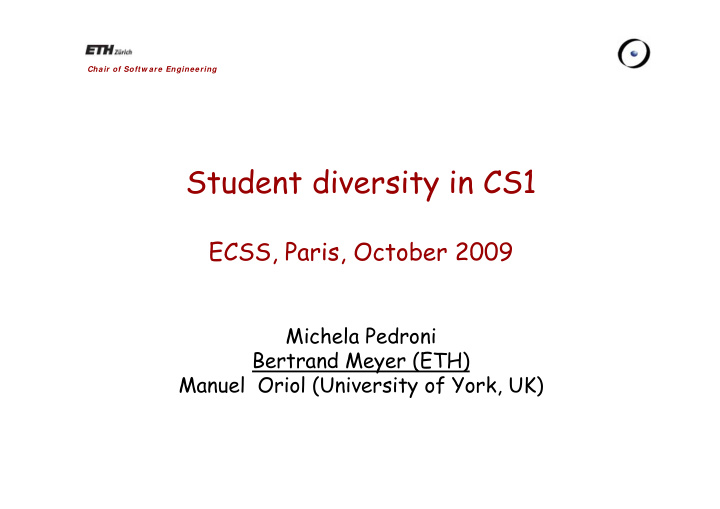



Chair of Softw are Engineering Student diversity in CS1 y ECSS Paris October 2009 ECSS, Paris, October 2009 Michela Pedroni Bertrand Meyer (ETH) y ( ) Manuel Oriol (University of York, UK)
Context Introduction to Programming course at ETH Zurich Since 2003 2
Motivation To “know your audience” is one of the fundamental rules of y mass communication In introductory programming courses: y p g g high diversity of prior knowledge 3
Study setup Questionnaire on computing and programming knowledge Computer literacy p y Programming experience Programming languages g g g g Changes over years? Participants of ETH p f Beginning of Introduction to Programming 2003-2008 On paper (2003), later online On paper ( 003), later onl ne Answers from 753 of 1130 CS students Participants of University of York Participants of University of York 2008 only Differences between institutions? Online Online Answers from 77 of 101 CS & Math students 4
Computer usage Averages over 5 years, 1 year: 0% (0%, 0%, 1%) 2003-2007 2003 2007 2 to 4 years: 3% (yearly variations small) (3%, 4%, 1%, 6%) 5 to 9 years: 42% y (35%, 48%, 35%, 55%) (62%, 48%, 63%) 10 years: 59% 5
Programming experience 70% 60% 60% Small O-O programs 50% students s 40% No O-O 30% 20% No programming 10% 10% Large* programs 0% 03 03 04 04 05 05 06 06 07 07 08 08 08 08 ETH York 6
Where learning occurs 70% 60% 50% Self-study Self study ts 40% 40% student 30% At high school At high school 20% 10% Other Other 0% At university 03 03 04 04 05 05 06 06 07 07 08 08 08 08 ETH York 7
Number of languages known well or very well 50% 1-2 40% None 30% 30% students s 3 or more 20% 10% 0% 03 03 04 04 05 05 06 06 07 07 08 08 08 08 ETH York 8
Languages known by most students 1 st place 2 nd place 3 rd place 2003 Basic Pascal C++ 2004 2004 Eiffel Eiffel C++ C++ JavaScript JavaScript 2005 C++ Java PHP ETH ETH 2006 PHP JavaScript Java 2007 PHP Java JavaScript/C++ 2008 2008 PHP PHP C C++ C C York 2008 VisualBasic JavaScript p PHP 9
Comparisons Changes over the years (ETH only) Many differences between 2003 and later years : In y y 2003, less exposure to computers, less programming experience, less languages known well/very well Only punctual differences involving other years: Laptop, specific programming languages (Basic and Eiffel) Eiffel) Situation is stable York vs. ETH (2008 only) Only punctual differences • BSD operating system, computer tasks • Different knowledge of Java and VisualBasic Si il Similar at both institutions t b th i tit ti 10
Implications on teaching Students are mostly computer literate, but very diverse ~1/3 programming novices p g g ~1/3 know one or two languages well or very well ~1/3 know more than two languages g g Situation is stable and similar at two institutions Is this a global phenomenon? Need more data… g p m m Develop measures to adapt to diverse student body Teaching methodology: software framework Teaching methodology: software framework, programming language choice, relate to prior knowledge g Extra lessons for novices (e.g. CS0) Making student groups g g p Individualized instruction 11
A complementary experiment How are we doing? Test in 2 nd year, programming questions; first experience in February 2009 Language-independent, but uses programming language taught in introductory course Analysis: 3 equal categories Will do it again in February 2010 12
If If you are willing to participate in the studies, u illin t p ti ip t in th studi s please write to pedronim@inf.ethz.ch 13
Recommend
More recommend